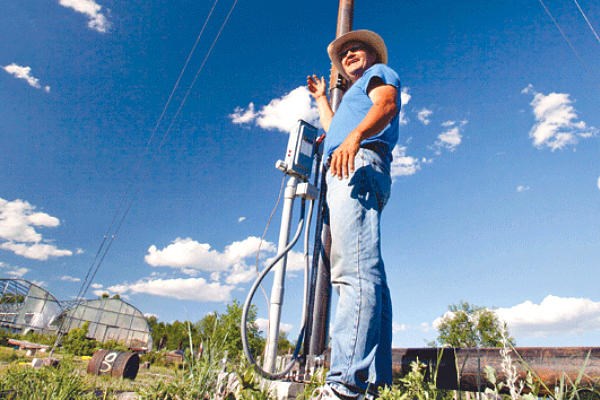 |
| Henry Red Cloud directs the work of Lakota Solar Enterprises, his American Indian-owned and operated business dedicated to providing renewable energy to some of the poorest communities in the United States.
Photo by Dan Bihn |
Henry Red Cloud's address is 1001 Solar Warrior Road on the Pine Ridge Indian Reservation in South Dakota. But the road sign hasn't arrived. A windmill towering over the cottonwoods in the draw of White Clay Creek marks the location of Red Cloud Renewable Energy Center and his "Solar Warrior Community."
It consists of a mud-and-straw-bale roundhouse for trainings, a whimsically painted Quonset hut factory for assembling solar air heaters, an array of solar panels from Germany, a horse trailer that doubles as a paper recycling center for making insulation, a vegetable garden, and a new concrete foundation for what will become a 20-person dormitory.
Here Red Cloud directs the work of Lakota Solar Enterprises, his American Indian-owned and operated business dedicated to providing renewable energy to some of the poorest communities in the United States.
The business has been part of a journey home for the 52-year-old Oglala Lakota man. He left the reservation to join the civil rights movement in the 1970s, then found himself working construction, walking high steel in cities around the country.
But when he returned home, he faced the reality of few jobs and little housing. He crafted teepees and took volunteer training from Trees, Water & People, which later became his partner organization.
One night, trying to sleep in the back seat of his car, Red Cloud had the vision for Lakota Solar: training people right on the reservation to build and install solar heaters so they could study at home and support the extended family, or tiospaye. Later, he added a buffalo-ranching cooperative to the enterprise.
"The house, the buffalo, renewable energy: I'm not into it to become a millionaire," Red Cloud says. "I'm just here passing it on to the next generation like the grandfathers did for us. That way surely their prophecy is going to be realized."
Red Cloud's 16-month-old granddaughter is the seventh generation descended from Makhpiya Luta, or Chief Red Cloud, who negotiated the 1868 Fort Laramie Treaty, which left 60 million acres of buffalo hunting grounds to the Great Sioux Nation – until Congress later whittled it into smaller reservation parcels.
"Our ancestors made a treaty with the US government," Red Cloud recounts. But they also made "a pact with the Creator for seven generations" – hearkening to a well-known prophecy that they would suffer if they did not provide for their descendants' future prosperity.
Red Cloud was raised by his grandparents. "You can get an education and you can live a comfortable life," he remembers his grandfather saying, "but if you want to have a really good life, create some work for other people."
To date, the Red Cloud Center has trained 84 people, most of whom have secured jobs based on the experience – a striking accomplishment given the staggering unemployment across Indian country.
Lakota Solar Enterprises has built and installed more than 1,200 small-scale individual solar heating systems. The heaters save low-income homeowners up to 30 percent on utility bills that, over the course of a freezing Northern Plains winter, can add up to more than $1,000.
The systems are Red Cloud's own innovation: For two years, he fiddled with a 1970s design to come up with the $2,500 unit his business produces today.
"We're using 21st century material and tweaking it Lakota-style," he says.
Recently, Red Cloud has engaged 24 Northern Plains tribes as partners. The tribes have been spending millions of dollars of federal funding to assist tribal members with energy costs, such as propane. Now they can use some of the money for energy efficiency and to send tribal members to Red Cloud's renewable energy courses.
Red Cloud also has contracts to install wind turbines and solar arrays atop public health clinics on the Pine Ridge and Rosebud Indian Reservations. He hopes the projects will help topple what he considers to be a wall of skepticism about green building techniques – the legacy of failed development projects on the reservations.
"We are just getting back to the memory of the old way and becoming sustainable again," Red Cloud says. "We have always had our Sun Dance ceremonies. We're warriors doing our warriors' deed in the 21st century for the seventh generation."
Page created on 3/23/2012 12:00:00 AM
Last edited 1/5/2017 4:34:17 PM
* This article first appeared in YES! Magazine.
